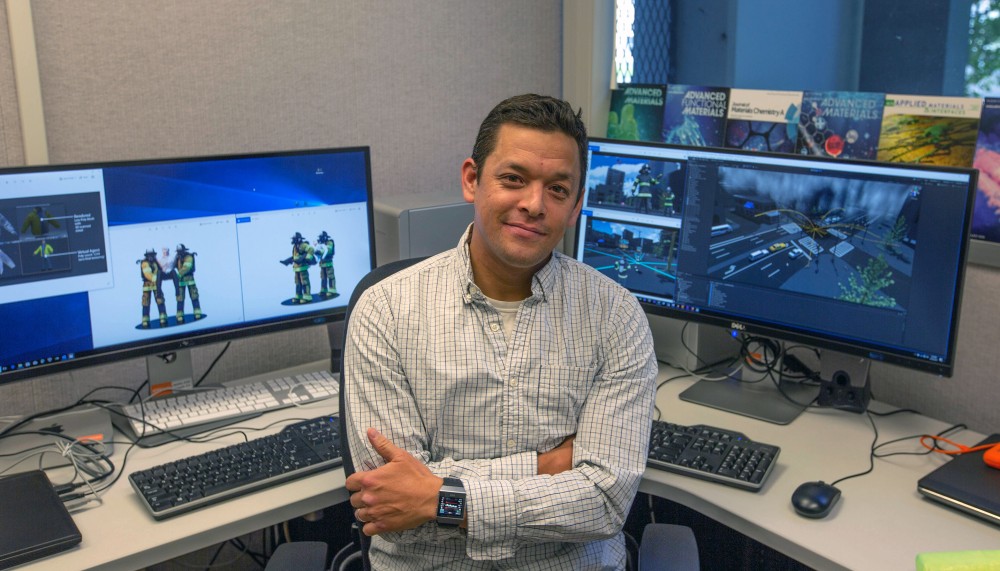
Thanks to the efforts of data analyst and visualization technologist Ryan Chen, of the Lawrence Livermore National Laboratory, a new model gives emergency responders a means of simulating and testing a situation no one ever wants to witness firsthand: the explosion of a radiological dispersal device (RDD).
Better known as dirty bombs, such devices are explosives paired with radioactive material. Their purpose is to spread radioactive contamination around explosion sites and the surrounding area, weather-depending. For obvious reasons, they aren’t something that can be trained for in the field, but thanks to Chen’s RDD Studio, an optimal response can be calculated and given life in the safety of an office.
The system simulates the explosions that fling ballistic source fragments and the downwind ground contamination which follows. Data pulled from the aftermath of real explosive tests mix with a computational fluid dynamic atmospheric dispersion model to create for the user a contaminated urban environment. From there, RDD Studio proceeds to demonstrate the tactics responders should follow from guidance provided by the Department of Homeland Security (DHS).
“The RDD Studio simulator was designed to be easily modified in order to test and display a wide variety of response scenarios,” Chen said in an interview with Homeland Preparedness News. “The simulator was designed to be quickly reconfigured to use any real-world urban environment that has the necessary building footprint data needed to construct the virtual environment. Once the environment is properly loaded, designating the location of key scenario elements like the detonation point and the incident command post is easily achieved by selecting a point on a map. The flexibility provided by RDD Studio allows users to test the 5 missions and 10 tactics described in the DHS RDD response guidance on the street corner or intersection of any big city or small town.”
That guidance refers to the DHS Science and Technology Directorate report “RDD Response Guidance: Planning for the First 100 Minutes,” which was first published in 2017. It has since taken the form of 14 videos hosted by DHS S&T. Chen’s model was released in April – the product of work that first began taking shape in 2016, as a way to create custom animations of large and complex response scenarios.
“Put simply, RDD Studio started as a tool to make visuals for communicating science and tactics, but later became a tool for analyzing the benefits of specific response tactics,” Chen said.
Now, a whole host of factors can be taken into account. Response tactics can be tested against different source types, activity levels, number of explosive fragments, the size of those fragments, nearby population and number of casualties, to name a few. It is, as its designer says, an iterative process that has taken into account feedback from the larger emergency response community, and as such, reflects their operational methods alongside its other calculations.
Based on computational fluid dynamic simulations generated by the National Atmospheric and Release Advisory Center (NARAC) at LLNL, Chen notes that once the real world environment is taken into account, the model demonstrates how buildings and wind fields in a region can disperse contaminants downwind.
That said, Chen adds that the danger tends to be focused on the blast areas themselves.
“Though it is nice to have this type of data for demonstrations, the amount of exposure outside the immediate 20-meter blast area is typically very low,” Chen said.
Even within that blast area, part of the message of the program is that life-saving operations should not, in Chen’s view, be delayed merely due to the presence of radiation. Despite the dangers of the situation, appropriate Personal Protective Equipment and tactics can go a long way to minimize responders’ exposure. As DHS itself has pointed out in a fact sheet on radiological attacks, some of the best things people can do in the aftermath of such disasters are to maximize their distance from the source, because even short distances from the scene will see dramatic radiation rate drops.
“Even with conservative assumptions of a very large radioactive source term, the simulation demonstrates that overall responder exposures would be far below the level requiring any medical countermeasure,” Chen said. “In fact, in most scenarios even the highest exposed responder would still get less than the 5 rem annual exposure limit of occupational radiation workers, and none exceeded the 25 rem national guideline for lifesaving activities. Responders may encounter brief moments of relatively high radiation fields but as long as they use the tactics in the guidance and get in and out as quickly as possible, their overall total dose from the scenario will be far below any acute health concern.”
This is especially good news, since there are no reliable antidotes for inhaled or ingested radioactive material, though symptoms can be treated. Consumption of materials such as Prussian blue and potassium iodide tablets are useful for specific cases. Mostly, though, for responders and victims alike, it’s about covering mouth and nose, avoiding plumes and dust clouds, removing contaminated clothes soon after exposure and washing the skin post-contamination.
With these practices, coupled with knowledge of the proper tactics needed for management that RDD Studio provides, responders may have all they need to guarantee that they are able to help victims of these crises, without endangering themselves in the process.




